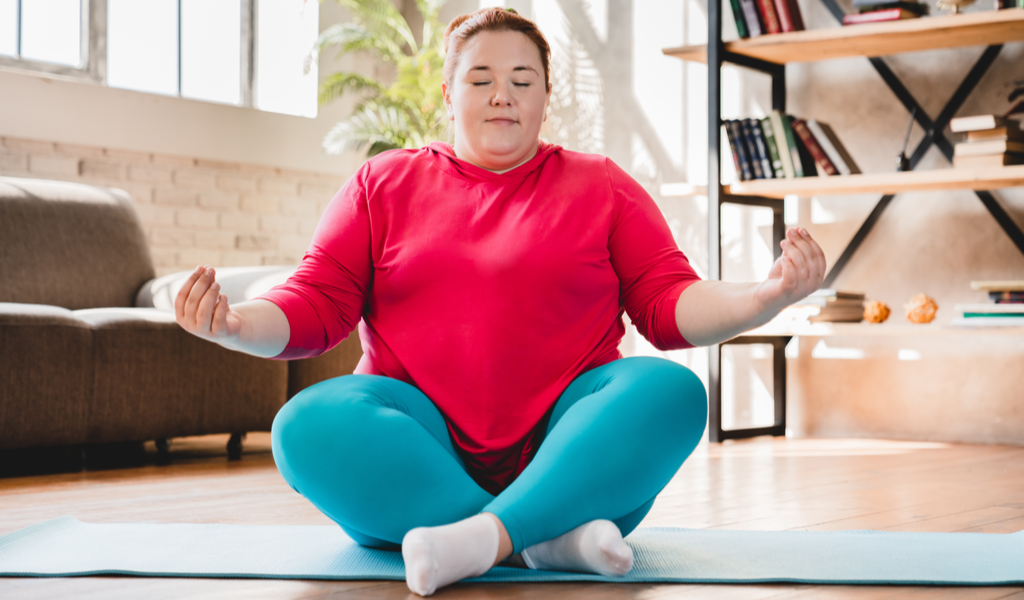Going back several thousands of years, Eastern cultures have always believed in doing breathing exercises as a way to boost overall health. Science is catching up only now as a number of recent studies have found a link between breathing exercises and a reduction in anxiety and stress levels, as well as improvements in attentiveness, quality of sleep, and emotional well-being.
Beyond the mental health benefits, some advocates of the practice even claim that making breathing exercises a part of your daily routine could aid in weight loss and boost fat burning. Is there any truth to this claim? Let’s explore the science behind it further to determine whether breathing exercises can help you lose weight.

What Are Breathing Exercises?
It is a simple practice of minimizing external distractions so you can pay closer to your breathing. But this simple practice has been linked to numerous health benefits as we saw above. There are many different types of breathing exercises. Here are a few of the most common ones:
Deep Breathing: The most popular breathing exercise involves taking a deep breath, holding it for a few seconds, and exhaling slowly.
Alternate Nostril Breathing: In this breathing technique, you practice inhaling and exhaling through alternative nostrils by using your fingers to shut off one side at a time.
Pursed Lip Breathing: In this breathing exercise, you would practice breathing in through the nostrils and breathing out slowly through pursed lips.
Humming Bee Breath (Bhramari): This is a yoga breathing practice where one is made to inhale normally, then partially cover their ears as they make a humming sound through a closed mouth as they exhale slowly.
Diaphragmatic Breathing: This breathing technique is also called belly breathing as it makes use of muscles in your stomach. It requires you to lie down and place your hands on your upper chest and rib cage. Then you would inhale through the nostrils and exhale through pursed lips as you tighten your stomach muscles.
Sitali Breath: This is another yoga breathing practice in which a person slowly extends the length of their breath without forcing it. You are also supposed to curl your tongue and inhale through the mouth, then exhale through the nose.
Senobi: This is a Japanese breathing practice where one leans back and stretches their arms overhead before inhaling and exhaling slowly.
Different styles of breathing may have slight variations in how they are practiced, but they are all done with the ultimate goal of promoting relaxation and stress relief by ultra-focusing your attention to the present moment.
But What About Weight Loss?
A number of studies have found that regular practice of breathing exercise may help in weight loss and reduction of body fat. An 8-week study that followed a group of people who practiced breathing exercises for 45 minutes a day, 3 times a week, discovered that there was a significant reduction in body weight and BMI (Body Mass Index) of the participants when compared with a control group.
Another study focused on 40 women who practiced Senobi breathing exercises found that there was an increase in both, the excretion of hormones through urine and sympathetic nerve activity – you know, the one responsible for your body’s fight or flight response. Participants with obesity who repeated the breathing exercises regularly for a month reported a significant reduction in body fat as well!
Yet another small study, this time with only 38 participants who took up diaphragmatic breathing exercises, had a higher resting metabolic rate, which could also help in weight loss.

Helps Decrease Hunger and Appetite?
Findings of some studies say that practicing breathing exercises may help reduce one’s feelings of hunger, which could lead to a reduction in food consumption, and therefore, help promote weight loss.
One such research based on 60 people showed that performing a breathing exercise where they held their breath for 3-4 seconds while contracting their stomach muscles helped reduce feelings of hunger on an empty stomach.
A similar study that followed 65 women found that enduring slow-paced breathing for 10 minutes led to a substantial lessening in hunger.
Another study found that 68 people who practiced supervised yoga for 45 minutes, twice a day, every day for 15 days reported a significant decrease in BMI and belly fat. They were also found to have increased levels of leptin, which is the hormone responsible for stimulating feelings of fullness. 33 minutes of the supervised yoga they followed were made up of breathing exercises!
Lowering Stress and Anxiety
There are multiple studies that have proven that breathing exercises can be an effective way to lower stress levels. They can help curb feelings of anxiety, tension, depression, and even anger. As a result, your body will produce less of the stress hormone, cortisol. Given that increased levels of cortisol have been linked to a higher risk of weight gain and obesity, it is certainly beneficial to work on your emotional well-being if you intend to lose weight. In addition, an increase in cortisol levels can also potentially increase food cravings and cause stress-eating or emotional eating, which often tends to be junk or unhealthy food.
While there needs to be more research to cement these as facts, there is sufficient evidence to speculate that practicing stress-relieving actions such as deep breathing may aid in stopping overeating and promoting weight loss.
How Do You Get Started?
Starting out with breathing exercises doesn’t have to be time-consuming or dreary. You can start with small bursts of exercise throughout the day, ideally 3-4 times per day, taking just a few minutes each for each session.
What style of breathing exercise you pick depends on what you prefer. You can choose something more challenging like diaphragmatic breathing, or stick to the simplest one, good old deep breathing.
Start by finding a location where there are minimal distractions so that you can fully focus and get into a position that is comfortable, either standing or sitting. Practice your choice of breathing exercise for a few minutes, slowly increasing the duration of your sessions as you begin to feel more comfortable. Once you have found a routine that works well, you can go ahead and incorporate poses or mantras into the exercise. You can also incorporate other mindfulness exercises such as yoga or meditation.



